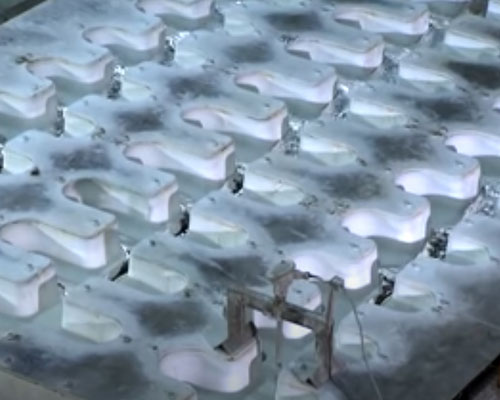Vertical semi-continuous casting is mainly used for the production of aluminum wire ingots, slab ingots and various deformed alloys for processing profiles. The molten aluminum is poured into the mixing furnace after batching. Due to the special requirements of the wires, the intermediate plate Al-B must be added to remove the titanium and vanadium in the molten aluminum before casting. The ingot needs to be added with Al-Ti-B alloy) for refinement treatment. Make the surface organization fine. Add a high-magnesium alloy with refining agent, the amount is 5%, stir evenly, stand for 30 minutes, remove the scum, and then cast.
Lift the chassis of the casting machine before casting, and blow off the moisture on the chassis with compressed air. Then raise the base plate into the crystallizer, apply a layer of lubricating oil to the inner wall of the crystallizer, put some cooling water into the water jacket, put the dry and preheated distribution plate, automatic regulating plug and launder in place, so that the distribution plate each port is located in the center of the crystallizer.
At the beginning of vertical semi-continuous casting, press the automatic adjustment plug with your hand to block the nozzle, cut open the furnace eye of the mixing furnace, and let the aluminum liquid flow into the distribution plate through the launder. When the aluminum liquid reaches 2/5 in the distribution plate, release the automatic Adjust the plug so that the molten aluminum flows into the crystallizer, and the molten aluminum is cooled on the chassis. When the aluminum liquid reaches 30mm high in the crystallizer, the chassis can be lowered, and cooling water will start to be sent. The automatic adjusting plug controls the balanced flow of the aluminum liquid into the crystallizer and keeps the height of the aluminum liquid in the crystallizer unchanged. The scum and oxide film on the surface of the molten aluminum should be removed in time. When the length of the aluminum ingot is about 6m, block the furnace eye, remove the distribution plate, stop the water supply after the aluminum liquid is completely solidified, remove the water jacket, take out the cast aluminum ingot with a monorail crane, and place it on the sawing machine according to the required size Saw it off and prepare for the next casting.

During vertical semi-continuous casting, the temperature of the molten aluminum in the mixing furnace is maintained at 690-7l0°C, the temperature of the molten aluminum in the distribution plate is maintained at 685-690°C, the casting speed is 190-21Omm/min, and the cooling water pressure is 0.147-0.196MPa.
Vertical semi-continuous casting is a sequential crystallization method. After the molten aluminum enters the casting hole, it begins to crystallize on the bottom plate and the inner wall of the mold. Because the cooling conditions of the center and the sides are different, the crystallization forms a form of the low middle and high periphery. The chassis descends at a constant speed. At the same time, molten aluminum is continuously injected into the upper part, so that there is a semi-solidified zone between solid aluminum and liquid aluminum. Because the aluminum liquid shrinks when it is condensing, and there is a layer of lubricating oil on the inner wall of the crystallizer, as the chassis descends, the solidified aluminum exits the crystallizer. There is a circle of cooling water holes in the lower part of the crystallizer, and the cooling water can be sprayed until it has escaped. The surface of the aluminum ingot is subjected to secondary cooling until the entire wire ingot is cast.
Sequential crystallization can establish relatively satisfactory solidification conditions, which is beneficial to the grain size, mechanical properties, and electrical conductivity of the crystallization. There is no difference in mechanical properties in the height direction of the comparative ingot, the segregation is also small, the cooling rate is faster, and a very fine crystal structure can be obtained.
The surface of the aluminum wire ingot should be flat and smooth, free of slag, cracks, pores, etc., the length of surface cracks should not exceed 1.5mm, the depth of slag and ridge wrinkles on the surface should not exceed 2mm, and the section should not have cracks, pores, and slag inclusions There are no more than 5 slag inclusions less than 1mm.

